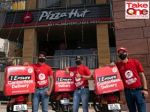
Fried & tested: KFC tops the pecking order
A boom in the fried chicken market post-Covid, the absence of formidable rivals and an insatiable appetite of Indian consumers for meat have unfurled the chicken wings of KFC and put it on the top of the QSR pyramid. Can it continue with its dream run?
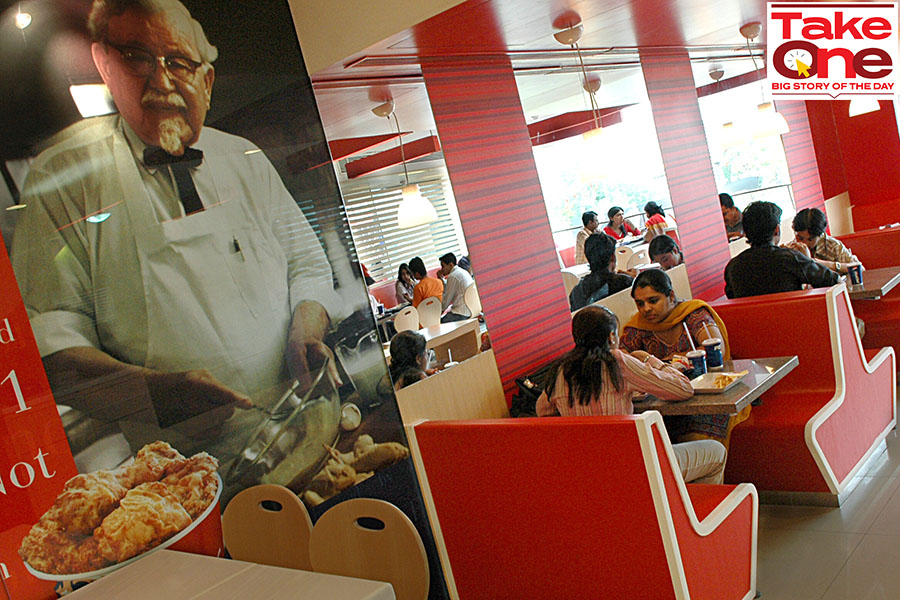 KFC Restaurant at Atta market in Noida, Uttar Pradesh, India. Image: Ravi S Sahani/The The India Today Group via Getty Images
KFC Restaurant at Atta market in Noida, Uttar Pradesh, India. Image: Ravi S Sahani/The The India Today Group via Getty Images
New Delhi. It was 2011. Though McDonald’s and KFC were no longer spring chickens, the former topped the pecking order in India and, therefore, earned the bragging and bullying rights. “Even if KFC comes right next to us,” Vikram Bakshi reportedly took a jibe at his rival brand and commented on the purported strategy of KFC to open outlets in proximity to the Golden Arches, “they gain nothing.” “To their Zinger, we've had our Spicy Burger,” the then-managing director of Connaught Plaza Restaurants, which used to run McDonald's franchises in north and east India, continued to flaunt their superiority. “They were worried... they had to call their Zinger Hot Zinger,” he reportedly added.
The failure to do so was largely to do with KFC’s depleted armoury. A former senior McDonald’s executive explains what McDonald’s had, and what KFC lacked in India. “I mean the biggest gap was the name itself. McDonald’s stood for an unambiguous burger, but KFC had fried chicken in its name,” says the veteran QSR analyst who worked with McDonald’s for over a decade. Back in the 90s, Indians were developing a taste for two alien QSR products—pizzas and burgers. In burgers, McDonald’s had a clear edge with a long list of India-specific localised products, especially vegetarian items such as McAloo Tikki Burger, panner burger, and, yes, Maharaja Mac, the Indian variant of the Big Mac. “KFC’s bucket list only had fried chicken, which was not a rage back then,” says the industry observer, declining to be named. “We used to taunt them by saying: You will get fried in India,” he recalls, adding that KFC was getting grilled between Domino’s on one side, and McDonald’s on the other.

What also hampered KFC’s prospects in India were multiple franchisees running the chicken show. After years of a flawed approach, Yum! Brands started to rejig its India operations from 2014 onwards, decided to settle for well-capitalised players, and towards the fag end of 2015, Sapphire Foods and Ravi Jaipuria-owned Devyani International emerged as the two big franchise partners to drive growth. Both were expected to ace the game of chicken.
Fast forward to March 2024, and KFC rules the roost. The fried chicken brand was the fastest-growing QSR chain in India between FY19 and FY23, according to a QSR (quick service restaurant) study by Elara Capital last month. While KFC posted a revenue CAGR (compound annual growth rate) of 30 percent to top the chart, it was followed by Burger King, Pizza Hut, McDonald’s and Domino’s (see box). Not only in terms of clocking the highest store CAGR, but in expansion too, KFC pipped McDonald’s, Burger King and Pizza Hut. Look at the numbers. In FY19, KFC had 292 stores in India. In the same fiscal, Westlife—McDonald’s master franchise partner in west and south India—had 296 stores; Burger King had 187, and Pizza Hut had 421. Four fiscals later, in FY23, KFC leapfrogged to 831 stores.
The real aggressive push, though, started in FY21. From 264 outlets, Devyani International took the KFC store count to 590 in the nine months during FY24. Revenues too grew briskly: From Rs644.3 crore to Rs1,549.6 crore. During the same period, Sapphire too marched at a furious pace. Stores jumped from 203 to 406, and revenues soared from Rs589.7 crore to Rs1,287.2 crore. In December last year, KFC took its store count to 1,000.
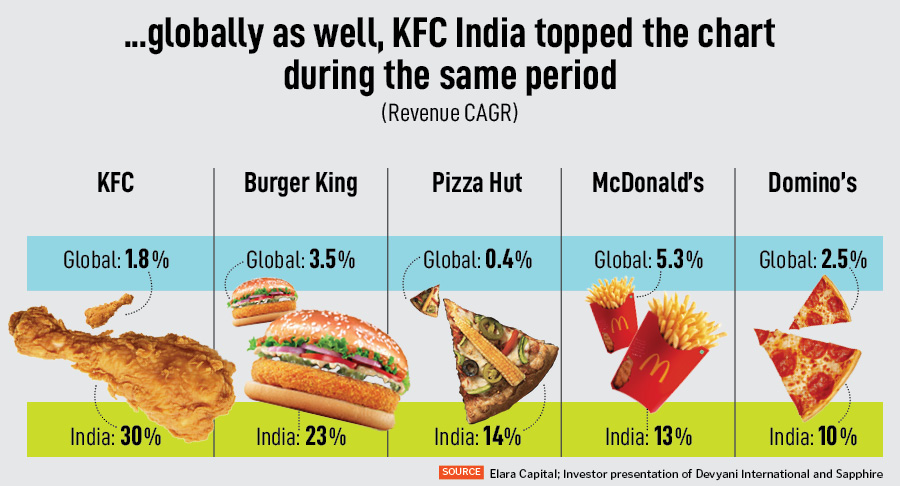
Ravi Jaipuria explains the magical run of KFC. “It’s a powerful brand globally, and in India,” reckons the non-executive chairman of Devyani International, and the chairman of RJ Corp. The burger and the pizza space, underlines the seasoned QSR expert, is dotted with multiple players. “But when it comes to chicken, there is no second to KFC,” says Jaipuria. “There is no competition. Anybody who loves crunchy or fried chicken will come to KFC,” he says, adding that KFC is yet to play to its potential in India. “China has 10,000 KFC stores,” he smiles. Though the China-India contrast is not an apple-to-apple comparison, he underlines, the fried chicken brand is primed to clock a furious pace of growth over the next few years.
Also read: Why are Indians ordering less pizzas, burgers and fried chicken
For KFC, the headroom for growth is indeed massive. The big reason? The fried chicken market is grossly under-penetrated. Among the top 20 cities in India, underlines Elara Capital in its report titled ‘Hunger Games’, penetration of the chicken category is low at 4.2 stores per million. Now contrast this data with pizza, and you will notice the staggering gap: 13.9 pizza stores per million. Among the top three cities in terms of population, Bengaluru has the highest number of Domino’s and Pizza Hut stores per million—29.4—followed by Delhi and Mumbai at 15.6 and 11.5, respectively. Pune has the highest pizza store density at 38.1 stores per million people, followed by Bengaluru, Thane at 23.4, and Chennai at 21.3. “On average, each state has around 2x more pizza stores than chicken,” the report concludes.
Cut to KFC. Bengaluru has the highest number of stores per million people at 8.2, followed by Delhi and Mumbai at 5.5 and 1.8, respectively. Pune again tops as the city with the highest store density at 9 stores per million, followed by Hyderabad at 8.6, Bengaluru at 8.2, and Chennai and Kolkata at 6.9 each. As compared to the pizza category, Elara Capital stresses in its findings, chicken has a low penetration in cities across India, thereby providing a golden opportunity for QSR firms to expand.
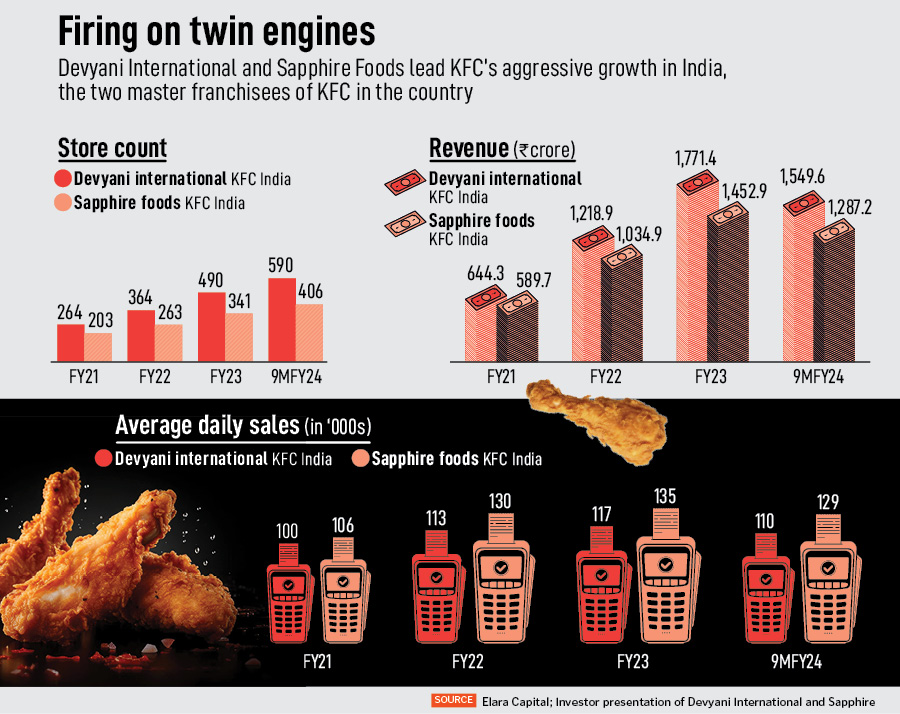
The QSR landscape, though, has been undergoing a tectonic shift. The fried chicken category has been growing at a brisk pace, and posted a market size CAGR of 18 percent over FY15-21 as against the QSR chain market at 10.8 percent during the same period. In FY18, chicken's market share in the QSR space was around 7 percent. By FY22, it increased to 10 percent. “Post the pandemic, the fried chicken category has become popular,” reckons the report.
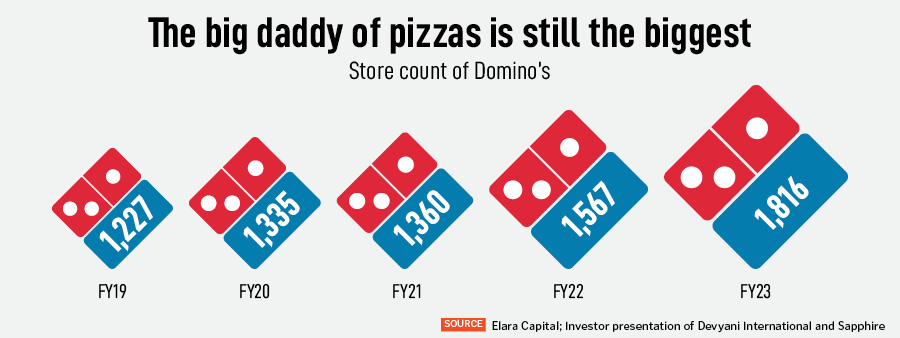
The rise of fried chicken in the QSR pie, interestingly, has coincided with a declining market share of Jubilant. “In the past four years, the relative market share dropped from 46 percent in FY19 to 35 percent in FY23,” claims the report, adding that the pizza category has been grappling with a flurry of new players who have made life tough for the two big boys—Domino’s and Pizza Hut. Take, for instance, the fight from brands such as Papa Johns, Smokin Joe’s Pizza, Chicago Pizza, La Pinos Pizza, and Mojo Pizza. “Competition is becoming intense… as a result, Jubilant has lost around 4 percent market share in the India QSR market,” the report adds.
Coming back to fried chicken, KFC too did its homework to ride with the tide of fried chicken. “Over the years, it fine-tuned its product to suit the Indian palate in terms of spice and flavour delivery with the extra hot and spicy variant,” reckons KS Narayanan, a food and beverage expert. The brand, he underlines, built a robust nationwide backend supply chain of partners, and offered a consistent product delivery which enabled it to grow at a faster clip. “Also, post-Covid, as deliveries picked up steam, the fried chicken category—which behaves well on delivery as compared to burgers—helped accelerate the trend further,” he says.
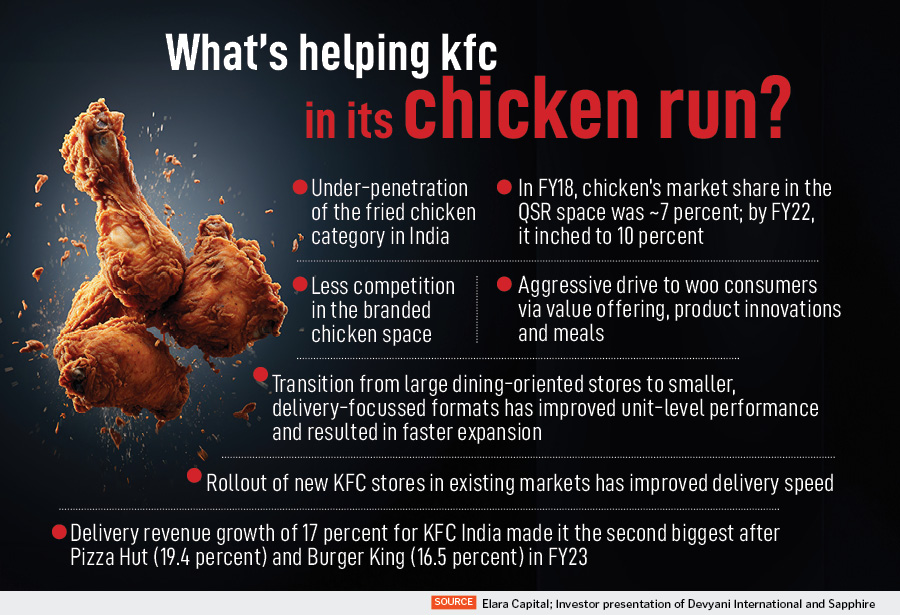
Innovations too did their bit in giving KFC an edge over rivals. “Value offerings through larger chicken buckets, launch of rice buckets and biryani with fried chicken helped,” says Narayanan. A faster growth in per capita income, plus a higher disposable income, accelerated the trend of delivery and dine-in consumption. “The capex per store for a KFC store is significantly higher as compared to a pizza outlet (almost 2 to 3x), and thus store expansion for KFC has been more calibrated,” he reckons.
The quick pace of KFC’s juggernaut has forced rivals to hop on to the fried chicken bandwagon. In 2020, McDonald's rolled out its fried chicken offering. Two years later, Jubilant rolled out the iconic Louisiana Chicken brand Popeyes in India. The competition, for sure, is heating up in the fried chicken market.
KFC, though, has little to worry about for now, reckon branding and marketing experts. Reason? It’s the brand name again. “KFC has fried chicken and taste in its DNA,” says Harish Bijoor, who runs an eponymous brand consulting firm. Taste, underlines Bijoor, is a formula that many have tried to emulate—much like the taste of Coca-Cola—but have failed. “While others—small as well as big players—have an offering, KFC remains the OG of fried chicken,” he says, adding that the OG status is not replicable. Though politically incorrect in terms of health, in terms of imagery, fried chicken is rich in taste. “KFC is a taste-led brand,” he says, adding that India is a fried food market. From samosas to pakodas and fries, India has fried food in its DNA. “This seems to have worked beautifully for KFC,” he adds.

The challenge for the brand now is to ensure that it doesn’t go ballistic in opening outlets. “Strong rivals are coming such as Popeyes, and consumers would get drawn by the novelty of the new brand and product,” says Ashita Aggarwal, professor of marketing at SP Jain Institute of Management and Research. KFC, she maintains, must be judicious in its choice of new markets. Pizza’s popularity has a lot to do with the fact that the product was alien to the Indian market. Fried chicken, she points out, is not. “Every nook and corner of the country has some or the other roadside stall serving fried chicken,” she says. “KFC must keep this in mind,” she says.
Jaipuria, for his part, swears by the popularity of the brand, the stickiness of the products, and an army of loyal consumers who are hooked to the taste. “There is no second to KFC,” he reiterates.



